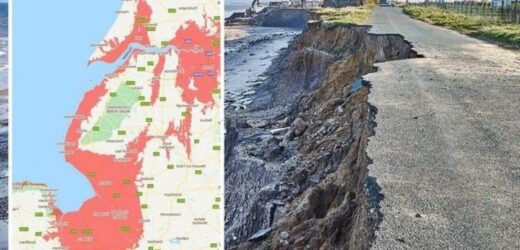Climate change: Map shows areas to be ‘below sea level’ in 2100
We use your sign-up to provide content in ways you’ve consented to and to improve our understanding of you. This may include adverts from us and 3rd parties based on our understanding. You can unsubscribe at any time. More info
Last year was the sixth hottest on record, with the global temperature 1.1℃ above the pre-industrial average, new analysis from NASA and the National Oceanic and Atmospheric Administration found. Temperature records were broken across the world, as California’s Death Valley recorded staggering highs of 54.4℃. An estimated 1.8 billion people, or a quarter of the world’s population, live in countries that experienced the hottest year on record.
Perhaps more alarming was that last year was another record year for heat content of the world’s oceans.
Human-emitted greenhouse gases trap heat in the atmosphere. While some of this warms the planet’s surface, the vast majority goes into the oceans.
The Earth would have warmed a lot, lot quicker if it was not for the large heat storage capacity of the oceans.
World leaders pledged to limit temperature rise to 1.5℃ by 2050 in the Paris Agreement, a feat that is widely believed to be very challenging but not impossible.


Professor Paul Bates, one of the UK’s hydrology and flooding experts, told Express.co.uk that even if this and the net zero emissions target are achieved, sea levels will continue to rise for a very long time regardless.
He said: “Even if we decarbonise very quickly and greenhouse gases start to come down, sea levels continue to rise for centuries still as the ocean continues to warm up and ice sheets start to discharge more of their ice into the oceans.
“Often with sea level rise, what you should be asking for is not whether this will happen, it’s when this will happen.
“It’s likely that sea levels will continue to rise for centuries and centuries even if we get to net zero by 2050 and stop pumping greenhouse gases into the atmosphere.”

He added: “Even if we do that [reach net zero emissions], sea levels continue to rise for centuries beyond that.
“So it’s all locked in already. We’ve done the damage.”
Met Office research confirmed that sea levels will continue to rise well beyond 2100 under all future emissions scenarios, and the severity of the rise is dependent on future greenhouse gas emissions.
Prof Bates explained that, even in a climate scenario where emissions peak in 2040 and begin to fall, London will experience sea level rise anywhere between 29 and 70 centimetres above the 1981-2000 average by 2100.
DON’T MISS:
23 Football stadiums at risk of flooding in 30 years – is your team’s? [REVEALED]
How much could Boris Johnson net zero strategy cost you? [INSIGHT]
Flooding costs to soar in ‘staggering’ new climate change warning [REPORT]

He explained: “It could be between 29 and 70 centimetres, and that’s what’s known as the five to 95 percent range.
“So there’s a 10 percent chance it will either be smaller or greater than that, but that’s just the most likely part of the range.
“And then by 2300, plus a metre and then if ice sheets collapse, it could be several metres.”
According to Met Office reports, dynamic ice discharge from the West Antarctic Ice Sheet would cause substantial additional sea level rise.

Sea level is currently rising at around three millimetres each year. Prof Bates said that although this is a “gradual change”, if humans “wait long enough and not do anything about it”, there could be disastrous consequences.
Many of our cities along big rivers have historically flooded quite regularly. Likewise, much of the eastern coast is often subject to flooding troubles, and is likely to be hit hardest by rising sea levels. Other areas likely to be affected include Portsmouth, Kensington and Chelsea, Greenwich and North Wales.
The Welsh coastal village of Fairbourne looks set to be the UK’s first victim of climate change — it will become the first community in the UK to be decommissioned, with residents not expected to receive any compensation for the loss of their homes.
A 2018 report by the Climate Change Committee, the Government’s independent advisers on climate change, warned that by the 2080s in England, “up to 1.5 million properties, including 1.2 million homes, may be in areas at significant level of [coastal] flood risk”.
Prof Bates said that, while the UK spends a lot of money on flood defences each year, we are not “well prepared for the flood risk we face currently”.
He added: “And climate change and population change is only going to make that worse. So I think we could do a lot better.”
Thousands of properties in the UK are flooded each year, often due to properties being built in flood risk zones.
Prof Bates said: “It depends what you think about that. But I look at that as being unacceptably high.
“I think we have too much flood risk in the UK currently and we don’t do enough to zone development and keep people out of harm’s way. So I think we could do more.”
Source: Read Full Article


